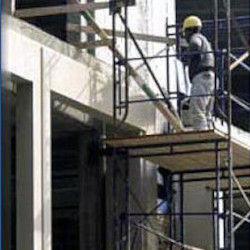Supported Scaffolds
Of the many types of supported scaffolds, fabricated frame scaffolds are the most common. Like portable ladders, they're versatile, economical, and easy to use.
You'll see them on construction sites as single supported platforms and multiple platforms stacked several stories high on modular frames.
If you work on a supported scaffold more than 10 feet above a lower level, you must be protected from falling. Supported scaffolds must meet the following requirements:
- Guardrails at least 42 plus or minus 3 inches high are appropriate for most scaffold platforms.
- If you can't use a guardrail system, then you must use a personal fall-arrest system or restraint system.
- Scaffolds must be able to support their own weight and at least four times the maximum intended load. The maximum intended load includes workers, equipment, and supplies.
- Platforms must not deflect more than 1/60 of the span when they are loaded.
- Platforms must be fully decked or planked between the front uprights and the guardrail supports.
- Scaffold components made by different manufacturers may be mixed, provided they fit together without force and maintain structural integrity.
- Scaffolds must be erected, dismantled, or moved only under the supervision of a competent person. The competent person must be on site to direct and supervise the work.
Knowledge Check Choose the best answer for the question.
4-4. At what height above a lower level must workers be protected from falling when working on a supported scaffold?
You forgot to answer the question!

